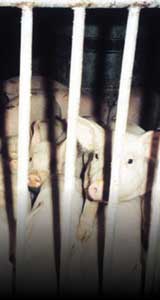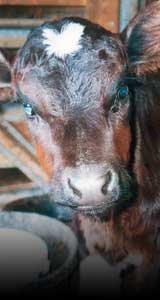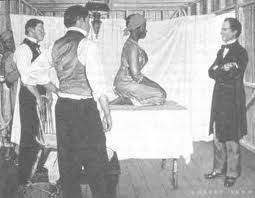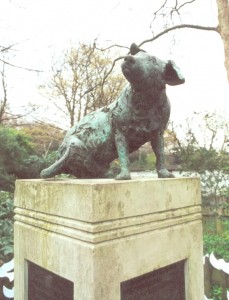Guest post by Nancy Heitzeg, reprinted with permission from Critical Mass Progress

 “In Memory of the Brown Terrier Dog done to Death in the Laboratories of University College in February 1903, after having endured Vivisection extending over more than two months and having been handed from one Vivisector to another till Death came to his Release.
“In Memory of the Brown Terrier Dog done to Death in the Laboratories of University College in February 1903, after having endured Vivisection extending over more than two months and having been handed from one Vivisector to another till Death came to his Release.
“Also in Memory of the 232 dogs vivisected at the same place during the year 1902.
“Men and Women of England, how long shall these things be?’
—National Anti-Vivisectionist Society
London 1902. What is now known as “The Brown Dog Affair” is the the first undercover investigation of animal experiments by anti-vivisectionists. The case began in December 1902, when Professor Starling at University College London performed his first operation on the terrier dog, depriving it of the use of its pancreas. During the following two months the dog lived in a cage, upsetting many with its howls and whines.
“In February 1903, Professor Starling opened up the dog’s abdomen to inspect the result of the first operation. He then clamped the wound with forceps and handed the animal over to Dr. Bayliss, who made a completely new wound in the neck for the purpose of a lecture demonstration to students. After another half hour, the animal apparently suffering greatly, was given to Mr. Dale, an unlicensed research student who killed it either by chloroform or by surgical means.”
In attendance that day were two Swedish anti-vivisectionists, Leisa Schartau and Louise Lind-af-Hageby. They had enrolled as students at the London School of Medicine for Women so that they could learn first-hand about the work in such laboratories, attended that lecture demonstration. They carefully noted the facts of this case in their diary, in which they were recording the details of the experiments they had witnessed during their studies at UCL. Schartau and Hageby soon after gave up there studies and decided to show their diary, which was now a substantial manuscript, to the Honorary Secretary of the National Anti-Vivisection Society, the Hon. Stephen Coleridge. The information which they recorded was published as a book entitled ‘The Shambles of Science’, which documented both the cruelty and the levity that surrounded the live dissection of animals in medical lectures.
A decades long public and legal battle ensued with accusations of legal violations, a much publicized libel suit brought against Coleridge, public protests, a statue erected in honor of the Brown Dog, and its’ eventual removal due to a series of “Brown Dog Riots” — on-going clashes between medical students bent on destroying the statue and anti-vivisectionists known now as “brown-doggers”.
But The Brown Dog of course remained dead. And vivisection continued apace, albeit now ever shrouded in more secrecy.
Because these dogs were deemed less than human.
They were only animals, and above all, they were property.

 “The animals of the world exist for their own reasons. They were not made for humans any more than black people were made for white, or women created for men.” –Alice Walker
“The animals of the world exist for their own reasons. They were not made for humans any more than black people were made for white, or women created for men.” –Alice Walker
At the heart, the critique of capitalism, indeed the indictment of all hierarchical class arrangements, is a critique, not only of profit, but of private property. It is private property that gives rise to social inequality, to the ever-shifting stratification of those who own a particular mode of production be it agricultural, industrial or post-industrial and those who labor under it.
And the first ownership, the first domination, is that of humans over nature, in the ownership of land and the “domestication” of animals. As humans shift from foraging to horticulture and herding, the relationship between humans and nature is shifted from one of kinship to dominion. And of course from there it is a short journey to the subjugation of other humans according to class, race, gender and age.
The roots of anthropocentrism and specieism run deep in Western/Euro-centric thought. They are evident in dominionist interpretations of the Judeo-Christian Creation Story, in the philosophy Aristotle ( i.e. The Great Chain of Being), and in Cartesian idealism and mind/body dualism. Of course the rise of capitalism coincides with the rise of the mechanistic, reductionist and misogynist “science” of Bacon and the race and species classification schemes of Linneaus, and the Industrial era fuels an unprecedented exploitation of both nature and animals.
Marx and Engels both warn of the dangers of unchecked anthropocentrism throughout their work, including Capital and the Dialectics of Nature. The relationship between humans and nature is central to their theory.
Nature is man’s inorganic body – nature, that is, insofar as it is not itself human body. Man lives on nature – means that nature is his body, with which he must remain in continuous interchange if he is not to die..
Estranged Labour, Economic and Philosophical Manuscripts of 1844
Too often, the anti-capitalist critique has focused centrally on the question of classism, to the exclusion, as argued recently of its’ intersections with racism, sexism, heterosexism, ageism and ableism. And. despite recent explorations of the Marxist position on nature, the foundations of human inequality in anthropocentrism and speciesim are even less explored.
What follows is an argument for an anti-capitalist consideration of ecological and animal rights and a rejection of the rock bottom root of all relations of domination.
A rejection of the notion that deems them less than human.
A rejection of the notion that they are only animals, and above all, they are property.

 “Animals are not ours to eat, wear, experiment on or use for entertainment.” – People for the Ethical Treatment of Animals
“Animals are not ours to eat, wear, experiment on or use for entertainment.” – People for the Ethical Treatment of Animals
The ownership of earth and animals is an extensive and often unquestioned element of industrial production. While there has been much focus on the exploitative impact of mining, drilling for fossil fuels and manufacturing, the large-scale and unrelenting industrialization of agriculture – both the production grains and meat – represents the greatest threat to planetary and animal well-being. From the mid-twentieth century on, this has accelerated at an astounding pace, fueled by massive amounts of chemicals –pesticides and herbicides, hormones, antibiotics and the mass production,assembly line methods of the factory.
Increasingly reductionist, the ownership of plants and animals extends now to DNA. The landmark case of Diamond v Charkarbarty (1980) allowed for the patenting of “life forms” and paved the way for the bio-tech biopiracy of seeds by the Monsantos and Cargills and new profits in genetically engineered laboratory animals and future markets in FDA approved cloned meats.
The sheer volume of profits in ownership of animals as “livestock” in the U.S. alone represents annual profit of more than $100 billion and the power of Big Ag lobbies such as the National Pork Producers Council and National Cattleman’s Beef Association are far-reaching. Just Ask Oprah. In fact. these “animal enterprises” are so lucrative and powerful that under the terms of The Animal Enterprise Terrorism Act of 2006 an efforts to intentionally “damage or cause the loss of any real or personal property” -in other words mere vandalism – is now defined as an act of terrorism.
The highly protected profits are surely high,but the body count is even more astounding:
In all, 59 billion animals –660,00 per hour- died to feed Americans in 2009. Over a lifetime, this amounts to 15,000 animals per meat eater.
In 2009, the average American meat eater was responsible for about 198 deaths:
1/7 of a cow, 2/5 of a pig, 1 turkey, 1½ chickens for eggs, 25 chickens for meat, 40 fish, and 130 shellfish
In addition:
Approximately 30 million animals die each year for medical and psychiatric research, dissection labs, military and consumer product tests.
Untold millions are killed annually for their skins. 85% are raised on fur farms; the rest are trapped or clubbed.
Untold millions more languish and die in circuses, rodeos, zoos, fairs, bullfights, cockfights, dogfights, horse and dog racing, and road side exotic animal shows.
The suffering??? Immeasurable — cramped, beaten, drugged, deprived of any and all natural habitat and habits, debeaked, defanged, declawed, castrated, mutilated, branded all without anesthetic, trucked for days in all conditions without food or water to their final destination to be stunned, shocked, throats slit and all too often, skinned or boiled alive.
Because they are deemed less than human.
They are only animals, and above all, they are property.

 “Throughout the history of our ascent to dominance as the master species, our victimization of animals has served as the model and foundation for our victimization of each other…The road to Auschwitz begins at the slaughterhouse.” – Charles Patterson, Eternal Treblinka, 2002
“Throughout the history of our ascent to dominance as the master species, our victimization of animals has served as the model and foundation for our victimization of each other…The road to Auschwitz begins at the slaughterhouse.” – Charles Patterson, Eternal Treblinka, 2002
Like all structures of inequality, anthropocentrism and speciesism are supported by ideological justifications which legitimate discriminatory treatment, in this case, as property. It has variously been argued that animals cannot reason, cannot experience pain as humans do, are incapable of developing tools or sensing their own mortality.
Although specieism is one of the most entrenched and unexamined pieces of the hegemony of hierarchy, language reveals the ordering of species and the attendant protections they may or may or may nor receive. There are the companion animals, the service animals, the work horses, “wildlife”, livestock aka “living property” and the even less regarded world of reptiles and amphibians and insects, most frequently referred to as mere “pests”. Their fate and the few exceptions from cruelty rest on their proximity to humans and at best, are rights in the negative sense of protection from “cruelty. This is afforded only to the companion animals. Most mammals are only granted some theoretical exemption from excessive cruelty as they are experimental subjects (see The Animal Welfare Act which excludes reptiles/amphibians and birds from protection) and or promised via The Humane Slaughter Act the hope of unconsciousness as they are hoisted, slit, gutted and skinned.
Speciesism was and remains the foundation for our vilification of “other” people, evident in the epithets we hurl their way — rat, snake, dog, pig, vermin, bitch, brute, animal. The naming of some humans as animals creates a re-enforcing feedback loop of domination. In her analysis of meat advertisements, The Pornography Of Meat, Carol Adams notes the continued connections:
“Meat is like pornography: before it was someone’s fun, it was someone’s life….Anthropornography — the depiction of non-human animals as whores -provides a way for men to bond publicly around misogyny. Not only do women promiscuously want sex, but the same desire is applicable to others in the ‘Not A’ category – nonhuman animals. Men can publicly consume what is usually private. Anthropornography gives you a hooker on your plate. Nonhuman animals are whoring for you. Nonhumans want you, too. Suffering? Slaughtering? Inhumane acts? No. They want it”
And the consequences are and have been greater than just the naming. However much offense may be taken at PETA’s often impolitic exposition of the connections between human and animal exploitation here’s the hard truth: a substantial literature documents how various groups — blacks, Native Americans, women, children, Jews, Arabs, have been deemed less than human, and beaten, branded, raped. mutilated, enslaved and exterminated as a result. Speciesism has been the platform upon which wars, slavery, sweatshops, lynch mobs, and death camps have been built; it is the bedrock of all inequality. Our domination of nature and its’ many species offers the paradigm and the practice for the oppression of “others”.
Because they are deemed less than human.
They are only animals, and above all, they are property.


To Feel No Pain
Montgomery will not give up her secrets easily.
Pouring rain
Whitewashes the shotgun shack.
Good old boys celebrate her fruits with their music….
—Anarcha Project
Montgomery Alabama 1846 -1853. Dr. J. Marion Sims (1813-1883) is now known as both “The Father of Gynecology” and “The Father of Vaginal Surgery”. Sims was born in South Carolina and practiced there, in Alabama, New York City, and throughout France. He is widely recognized for laying the foundations for modern gynecology, pioneering the use of surgical steel sutures, and developing several techniques in vaginal surgery. What is less known about Sims is “the fact that many of his accomplishments ….were obtained at the expense and the surgical exploitation of Black women”. While Sims went to some length to hide his use of slave subjects, featuring white women in anatomy articles and texts, his primary research subjects were three female slaves – Betsy, Lucy, and Anarcha. He operated on each of these women as many as 30 times without anesthesia, believing that blacks did not have the same capacity for pain as whites. Sims even went so far as to purchase Anarcha in order to continue operating on her. In addition, he addicted all these women to opiates in order to facilitate their post-operative recovery and expedite another round of surgeries.
After moving to New York in 1853, Sims continued his exploitation of poor and African American women, exposing them to dangerous experimental surgeries at the Women’s Hospital of New York City. Describing the death of an African American woman after such a surgery, MacGregor (1998) writes:
“Clearly from Sims’ point of view, the life of the patient in this case was expendable. Her body in many ways had become his even before she died… While he placed his findings at the altar of science, her class and her race placed her at Sims’ disposal.”
Because these women were deemed less than human.
They were only animals, and above all, they were property.


As long as space remains,
As long as sentient beings remain,
Until then, may I too remain
and dispel the miseries of the world.
— His Holiness the Dalai Lama
Human supremacy has wrought untold suffering. The notion that nature and its many species can be bought and sold and owned and exploited as property is at the root of the suffering of not only the Brown Dog but of Anaracha, Lucy and Betsy as well.
Whatever their differences, whatever their unique gifts and beauty, this much is true — “When it comes to having a central nervous system, and the ability to feel pain, hunger, and thirst, a rat is a pig is a dog is a boy“.
Human Supremacy is a Western conceit, one never adopted by those who are wiser. The ideas expressed here are old ones, never lost, just merely rediscovered by scholars and activists who resist the prevailing strands of Western thought.
Many now stand again against anthropocentrism and speciesism, recognizing that a critique of property relations and social inequality must challenge too this foundational domination. Many now see again that all beings have a fundamental right not to be considered property. Many now stand stand again for the abolition of all animal exploitation.
Because they are not less than human.
They are never mere property. They are Living, Sentient Beings.
Nancy A. Heitzeg, Ph.D is a Professor of Sociology as well as Director of the Critical Studies of Race and Ethnicity program at St Catherine University in St. Paul, Minnesota. Follow her on twitter here and check out her publications here. She blogs at Criminal Injustice.
VINE Sanctuary thanks our friend Nancy for generously allowing us to reprint this essay (and for retweeting us so regularly)! Click here to read more blog posts concerning intersections between speciesism and other forms of oppression. Visit the Connections section of our main website for even more thought-provoking analyses as well as links to further readings. If you appreciate our intersectional approach to animal advocacy, please consider supporting or volunteering for the sanctuary.
Commodities and Cages
Guest post by Nancy Heitzeg, reprinted with permission from Critical Mass Progress
“Also in Memory of the 232 dogs vivisected at the same place during the year 1902.
“Men and Women of England, how long shall these things be?’
—National Anti-Vivisectionist Society
London 1902. What is now known as “The Brown Dog Affair” is the the first undercover investigation of animal experiments by anti-vivisectionists. The case began in December 1902, when Professor Starling at University College London performed his first operation on the terrier dog, depriving it of the use of its pancreas. During the following two months the dog lived in a cage, upsetting many with its howls and whines.
In attendance that day were two Swedish anti-vivisectionists, Leisa Schartau and Louise Lind-af-Hageby. They had enrolled as students at the London School of Medicine for Women so that they could learn first-hand about the work in such laboratories, attended that lecture demonstration. They carefully noted the facts of this case in their diary, in which they were recording the details of the experiments they had witnessed during their studies at UCL. Schartau and Hageby soon after gave up there studies and decided to show their diary, which was now a substantial manuscript, to the Honorary Secretary of the National Anti-Vivisection Society, the Hon. Stephen Coleridge. The information which they recorded was published as a book entitled ‘The Shambles of Science’, which documented both the cruelty and the levity that surrounded the live dissection of animals in medical lectures.
A decades long public and legal battle ensued with accusations of legal violations, a much publicized libel suit brought against Coleridge, public protests, a statue erected in honor of the Brown Dog, and its’ eventual removal due to a series of “Brown Dog Riots” — on-going clashes between medical students bent on destroying the statue and anti-vivisectionists known now as “brown-doggers”.
But The Brown Dog of course remained dead. And vivisection continued apace, albeit now ever shrouded in more secrecy.
Because these dogs were deemed less than human.
They were only animals, and above all, they were property.
At the heart, the critique of capitalism, indeed the indictment of all hierarchical class arrangements, is a critique, not only of profit, but of private property. It is private property that gives rise to social inequality, to the ever-shifting stratification of those who own a particular mode of production be it agricultural, industrial or post-industrial and those who labor under it.
And the first ownership, the first domination, is that of humans over nature, in the ownership of land and the “domestication” of animals. As humans shift from foraging to horticulture and herding, the relationship between humans and nature is shifted from one of kinship to dominion. And of course from there it is a short journey to the subjugation of other humans according to class, race, gender and age.
The roots of anthropocentrism and specieism run deep in Western/Euro-centric thought. They are evident in dominionist interpretations of the Judeo-Christian Creation Story, in the philosophy Aristotle ( i.e. The Great Chain of Being), and in Cartesian idealism and mind/body dualism. Of course the rise of capitalism coincides with the rise of the mechanistic, reductionist and misogynist “science” of Bacon and the race and species classification schemes of Linneaus, and the Industrial era fuels an unprecedented exploitation of both nature and animals.
Marx and Engels both warn of the dangers of unchecked anthropocentrism throughout their work, including Capital and the Dialectics of Nature. The relationship between humans and nature is central to their theory.
Too often, the anti-capitalist critique has focused centrally on the question of classism, to the exclusion, as argued recently of its’ intersections with racism, sexism, heterosexism, ageism and ableism. And. despite recent explorations of the Marxist position on nature, the foundations of human inequality in anthropocentrism and speciesim are even less explored.
What follows is an argument for an anti-capitalist consideration of ecological and animal rights and a rejection of the rock bottom root of all relations of domination.
A rejection of the notion that deems them less than human.
A rejection of the notion that they are only animals, and above all, they are property.
The ownership of earth and animals is an extensive and often unquestioned element of industrial production. While there has been much focus on the exploitative impact of mining, drilling for fossil fuels and manufacturing, the large-scale and unrelenting industrialization of agriculture – both the production grains and meat – represents the greatest threat to planetary and animal well-being. From the mid-twentieth century on, this has accelerated at an astounding pace, fueled by massive amounts of chemicals –pesticides and herbicides, hormones, antibiotics and the mass production,assembly line methods of the factory.
Increasingly reductionist, the ownership of plants and animals extends now to DNA. The landmark case of Diamond v Charkarbarty (1980) allowed for the patenting of “life forms” and paved the way for the bio-tech biopiracy of seeds by the Monsantos and Cargills and new profits in genetically engineered laboratory animals and future markets in FDA approved cloned meats.
The sheer volume of profits in ownership of animals as “livestock” in the U.S. alone represents annual profit of more than $100 billion and the power of Big Ag lobbies such as the National Pork Producers Council and National Cattleman’s Beef Association are far-reaching. Just Ask Oprah. In fact. these “animal enterprises” are so lucrative and powerful that under the terms of The Animal Enterprise Terrorism Act of 2006 an efforts to intentionally “damage or cause the loss of any real or personal property” -in other words mere vandalism – is now defined as an act of terrorism.
The highly protected profits are surely high,but the body count is even more astounding:
In all, 59 billion animals –660,00 per hour- died to feed Americans in 2009. Over a lifetime, this amounts to 15,000 animals per meat eater.
In 2009, the average American meat eater was responsible for about 198 deaths:
1/7 of a cow, 2/5 of a pig, 1 turkey, 1½ chickens for eggs, 25 chickens for meat, 40 fish, and 130 shellfish
In addition:
Approximately 30 million animals die each year for medical and psychiatric research, dissection labs, military and consumer product tests.
Untold millions are killed annually for their skins. 85% are raised on fur farms; the rest are trapped or clubbed.
Untold millions more languish and die in circuses, rodeos, zoos, fairs, bullfights, cockfights, dogfights, horse and dog racing, and road side exotic animal shows.
The suffering??? Immeasurable — cramped, beaten, drugged, deprived of any and all natural habitat and habits, debeaked, defanged, declawed, castrated, mutilated, branded all without anesthetic, trucked for days in all conditions without food or water to their final destination to be stunned, shocked, throats slit and all too often, skinned or boiled alive.
Because they are deemed less than human.
They are only animals, and above all, they are property.
Like all structures of inequality, anthropocentrism and speciesism are supported by ideological justifications which legitimate discriminatory treatment, in this case, as property. It has variously been argued that animals cannot reason, cannot experience pain as humans do, are incapable of developing tools or sensing their own mortality.
Although specieism is one of the most entrenched and unexamined pieces of the hegemony of hierarchy, language reveals the ordering of species and the attendant protections they may or may or may nor receive. There are the companion animals, the service animals, the work horses, “wildlife”, livestock aka “living property” and the even less regarded world of reptiles and amphibians and insects, most frequently referred to as mere “pests”. Their fate and the few exceptions from cruelty rest on their proximity to humans and at best, are rights in the negative sense of protection from “cruelty. This is afforded only to the companion animals. Most mammals are only granted some theoretical exemption from excessive cruelty as they are experimental subjects (see The Animal Welfare Act which excludes reptiles/amphibians and birds from protection) and or promised via The Humane Slaughter Act the hope of unconsciousness as they are hoisted, slit, gutted and skinned.
Speciesism was and remains the foundation for our vilification of “other” people, evident in the epithets we hurl their way — rat, snake, dog, pig, vermin, bitch, brute, animal. The naming of some humans as animals creates a re-enforcing feedback loop of domination. In her analysis of meat advertisements, The Pornography Of Meat, Carol Adams notes the continued connections:
And the consequences are and have been greater than just the naming. However much offense may be taken at PETA’s often impolitic exposition of the connections between human and animal exploitation here’s the hard truth: a substantial literature documents how various groups — blacks, Native Americans, women, children, Jews, Arabs, have been deemed less than human, and beaten, branded, raped. mutilated, enslaved and exterminated as a result. Speciesism has been the platform upon which wars, slavery, sweatshops, lynch mobs, and death camps have been built; it is the bedrock of all inequality. Our domination of nature and its’ many species offers the paradigm and the practice for the oppression of “others”.
Because they are deemed less than human.
They are only animals, and above all, they are property.
To Feel No Pain
Montgomery will not give up her secrets easily.
Pouring rain
Whitewashes the shotgun shack.
Good old boys celebrate her fruits with their music….
—Anarcha Project
Montgomery Alabama 1846 -1853. Dr. J. Marion Sims (1813-1883) is now known as both “The Father of Gynecology” and “The Father of Vaginal Surgery”. Sims was born in South Carolina and practiced there, in Alabama, New York City, and throughout France. He is widely recognized for laying the foundations for modern gynecology, pioneering the use of surgical steel sutures, and developing several techniques in vaginal surgery. What is less known about Sims is “the fact that many of his accomplishments ….were obtained at the expense and the surgical exploitation of Black women”. While Sims went to some length to hide his use of slave subjects, featuring white women in anatomy articles and texts, his primary research subjects were three female slaves – Betsy, Lucy, and Anarcha. He operated on each of these women as many as 30 times without anesthesia, believing that blacks did not have the same capacity for pain as whites. Sims even went so far as to purchase Anarcha in order to continue operating on her. In addition, he addicted all these women to opiates in order to facilitate their post-operative recovery and expedite another round of surgeries.
After moving to New York in 1853, Sims continued his exploitation of poor and African American women, exposing them to dangerous experimental surgeries at the Women’s Hospital of New York City. Describing the death of an African American woman after such a surgery, MacGregor (1998) writes:
Because these women were deemed less than human.
They were only animals, and above all, they were property.
As long as space remains,
As long as sentient beings remain,
Until then, may I too remain
and dispel the miseries of the world.
— His Holiness the Dalai Lama
Human supremacy has wrought untold suffering. The notion that nature and its many species can be bought and sold and owned and exploited as property is at the root of the suffering of not only the Brown Dog but of Anaracha, Lucy and Betsy as well.
Whatever their differences, whatever their unique gifts and beauty, this much is true — “When it comes to having a central nervous system, and the ability to feel pain, hunger, and thirst, a rat is a pig is a dog is a boy“.
Human Supremacy is a Western conceit, one never adopted by those who are wiser. The ideas expressed here are old ones, never lost, just merely rediscovered by scholars and activists who resist the prevailing strands of Western thought.
Many now stand again against anthropocentrism and speciesism, recognizing that a critique of property relations and social inequality must challenge too this foundational domination. Many now see again that all beings have a fundamental right not to be considered property. Many now stand stand again for the abolition of all animal exploitation.
Because they are not less than human.
They are never mere property. They are Living, Sentient Beings.
Nancy A. Heitzeg, Ph.D is a Professor of Sociology as well as Director of the Critical Studies of Race and Ethnicity program at St Catherine University in St. Paul, Minnesota. Follow her on twitter here and check out her publications here. She blogs at Criminal Injustice.
VINE Sanctuary thanks our friend Nancy for generously allowing us to reprint this essay (and for retweeting us so regularly)! Click here to read more blog posts concerning intersections between speciesism and other forms of oppression. Visit the Connections section of our main website for even more thought-provoking analyses as well as links to further readings. If you appreciate our intersectional approach to animal advocacy, please consider supporting or volunteering for the sanctuary.